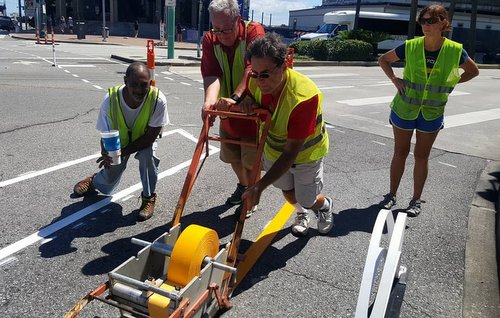
Volunteers paint a new bike lane near the ferry terminal on Canal Street. (photo via Bike Easy on Facebook)
By Samuel Kahn, Loyola Student News Service
Bike lanes are being added to Baronne Street by safety-vest wearing volunteers to demonstrate how bike lanes promote bike riding and bike safety as New Orleans hosts the 20th Walk Bike Places conference this week.
The event runs through Wednesday at the Sheraton New Orleans Hotel on Canal Street and bring together more than 1,500 city planners, lawmakers and bicycling advocates from around the world who want to promote alternative means of transportation. Events including bike tours, debates, panel discussions and mobile workshops are planned.
Downtown New Orleans streets are being painted with white lines and green blocks this week, to connect the existing bike lanes and provide a safer environment to cyclists. Look for the changes on Howard Avenue and Dryades, St. Louis and Basin streets.
Holding the paint rollers all week are the volunteers of Bike Easy, an organization based in New Orleans that advocates biking in the city.
“New Orleans is a city that has a high rate of cyclists and pedestrian mortality,” said Isabel Barrios of Bike Easy. “People need to understand that we need greater safety for bicyclists and pedestrians.”
To Dan Favre, director of Bike Easy, there is a direct link between bike lanes and safety for everyone on the road.
“It has been proven that when you build a bike lane, people use the bike lane, more people bike, more people follow the rules when they’re biking, more people wear helmets,” Favre said. “Bike lanes make things safer for everyone.”
As the paint dried this weekend on Baronne Street, cyclists were already riding the new bike lanes while cars passed by, kept at a distance by thick white lines.
Susannah Halbrook rides her blue bike mostly for pleasure. “Whenever I’m not going to work, I’m pretty much on my bike,” she said.
The absence of consistent bike lane citywide forces her to ride defensibly. “Even at times where I should have the right of way, I definitely take extra precautions because I know that drivers don’t always think I have the right of way,” she said. “Bike lanes make me a lot safer by giving me a designated space,” she said.
Quality outweigh quantity in term of bike lanes, Favre said. “We don’t need bike lanes in every street of New Orleans, but we need a network of bike lanes that are in the right places.”
The bike lanes painted by Bike Easy are supposed to last for three months, but organization members hope the lanes will remain.
“I think there is a pretty good chance that this would then become permanent with the city taking it over,” said Isabel Barrios.
The Loyola Student News Service features reporters from advanced-level journalism classes at Loyola University New Orleans, directed by faculty advisers.